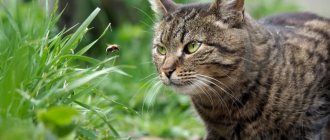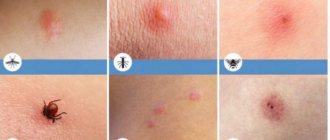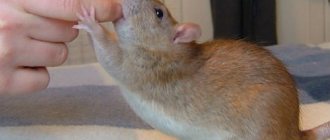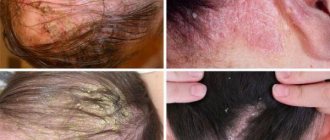Mouse bite
Mice, like other rodents, are dangerous to humans - they are carriers of infectious diseases. Pathogens that infect rodents can be transmitted through nutrition and airborne droplets, but the most dangerous is considered to be contact. If a mouse bites until it bleeds, you should seek medical help as soon as possible. The doctor will not only tell you what to do if you are bitten by a mouse, but will also give you a referral for tests, tetanus vaccination, and prescribe treatment.
The main dangers of mouse bites
Mice show aggression only when fighting for their own lives or the lives of their offspring. Sometimes a mouse may bite in agony, so a rodent caught in a mousetrap should not be handled with bare hands.
Diseases that can be contracted from mice pose a mortal danger to humans. It is important not to wait for signs of the disease to appear (symptoms do not appear immediately), but to go to the emergency room as quickly as possible.
Pathogens enter the human body through damaged skin with the saliva of a sick animal. Most often, wild and field mice suffer from the following pathologies:
- Leptospirosis. The incubation period is up to 14 days. This is an infectious disease caused by the spiral-shaped bacterium Leptospira, which belongs to the class of spirochetes of the genus Gram-negative. The disease disrupts the functioning of the nervous system, kidneys, and liver.
- Sodoku. The incubation period is up to 14 days, sometimes up to 2 months. The causative agent of the disease is spirillum minus. Manifested by fever, skin rashes, and attacks of arthritis. A deadly disease.
- Pseudotuberculosis. The incubation period averages about 8 days. There are several forms - some are dangerous to human life.
- Plague. The disease is characterized by extreme contagiousness and high mortality.
- Tularemia. The causative agent of zooanthroponotic infection is the bacterium Francisella tularensis. The incubation period can last 21 days, but on average it is 3–7 days. Fever lasts up to 30 days. Complications of the disease are meningoencephalitis, tularemia pneumonia, peritonitis, pericarditis, abscesses.
Recent studies have revealed that mouse mammary tumor virus, transmitted by rodents, can cause breast cancer in humans. Mice are often infested with blood-sucking arthropods, which are easily transmitted to humans.
Do mice bite?
In fact, gray eared cats, unlike their closest relatives, rats, are cowardly creatures and will not just attack a person. Mice show aggression only in a hopeless situation, when they have to defend themselves to protect their own skin.
Often, an animal reflexively uses its teeth while in its death throes, which is why it is undesirable to approach them at such moments, and even more so to touch the “suicide bomber” with bare hands.
If we are talking about decorative pets, then they bite only under stressful conditions, for example:
- when kept in a small house;
- with great crowding;
- when living in a noisy room;
- in a moment of fright.
Although decorative mice are often sterile in terms of infections, their bites are also potentially dangerous: pathogenic microflora can enter the wound and a strong inflammatory reaction will begin.
First aid
In any situation, a person who has been bitten by a mouse (even a domestic one) needs to competently provide first aid.
Afterwards, you should immediately go to the doctor, if possible taking the attacked rodent in a container or jar so that a laboratory can study whether the mouse could cause any infection.
If the skin is damaged to the point of bleeding, the algorithm for providing first aid after contact with a mouse should be as follows:
- You need to rinse the damaged area with running water and try to squeeze out as much blood as possible from the deep bite. The procedure should last at least 15–20 minutes. You can use laundry soap.
- Treat the damaged area with hydrogen peroxide. You can use iodine, alcohol, vodka or cologne if peroxide is not on hand.
- Apply a sterile dressing (bandage or bactericidal patch) to the wound.
Further assistance is provided by doctors. After examining the wound and assessing the condition of the victim, the specialist prescribes preventive vaccination against tetanus. To reduce the risk of infection, a course of antibiotic therapy is prescribed.
Not all diseases transmitted through a bite manifest themselves immediately, so the victim is registered. You will have to be under medical supervision for at least a month - most infections have a long latent period.
Consequences and complications
When asked by patients: “Can you die from a mouse bite?” medical workers say: “Yes!”
Gray animals are carriers of dangerous diseases. For example, if a mouse bite leads to infection with tularemia, tick-borne encephalitis, leptospirosis, and, less commonly, rabies, then in some cases the outcome can be fatal. After all, these infections affect the main systems of the body. Even if you manage to cure them, they usually result in various complications that can lead to disability.
Consequences of a mouse bite
People do not consider the bite of a small rodent dangerous, because rabies is transmitted through the bites of large animals, and no cases of infection with this dangerous disease from mice have yet been recorded.
Mice live in basements and garbage dumps. Rodents are omnivores, so their mouths are a breeding ground for pathogenic microorganisms. If the bite is deep, the bacteria can cause sepsis.
Sepsis
Most often, human hands suffer when handling rodents carelessly. In deep lacerated wounds, suppuration will certainly begin, so disinfection measures should be taken to ensure the release of pus.
Contact with a wild rodent can cause an allergic reaction even in people who have not previously complained of such symptoms. This may include redness, swelling, rash, or more severe symptoms.
The danger of gray rodents
To the question: “Can a mouse bite a person?” zoologists give the answer, “Yes!” This is true in several cases:
- There is a threat to the home. You can expect a bite from a field mouse if you step on its burrow while walking in a meadow. The animal jumps up and grabs your leg.
- There is a danger to life. Veterinarians are familiar with real life examples of a house mouse biting a sleeping person. This happened when an overly curious animal crawled onto a person and, at the slightest movement of the body, dug into the body.
- Danger to offspring. It happens that a wild mouse bites a child. Children on the street can find a hole and pull baby mice out of it. Then the female will definitely attack the invaders.
Important! If a rodent bites through the skin, there is a high risk of various diseases.
Since gray animals are permanent inhabitants of landfills and garbage containers, and they do not brush their teeth, the mouse’s oral cavity becomes a haven for all kinds of bacteria. When the human skin is injured, microbes enter the wound and the inflammatory process begins. It is especially dangerous for the elderly, young children, and people with weakened immune systems.
Prevention measures
When listing common diseases and infections, the carriers of which always live in a person’s neighborhood, it is necessary to note the basic precautions that will protect you and your family from unwanted symptoms.
Hand washing
- Personal hygiene, which includes washing hands after working with soil, exposed objects, as well as after walking and visiting the toilet;
- Washing fruits and vegetables, as well as greens, especially if you bought them in a store, since it is not known where they were stored and where they were brought from, before reaching the counter;
- Drinking boiled or filtered drinking water;
- Regular deworming of pets, dogs and cats;
- Timely testing for the presence of parasites in your body;
- Eliminate food items chewed by animals from the diet;
- If you have a vegetable storehouse, then if mice and rats are found, you need to take measures to bait them;
- Constant cleaning of the premises.
What can you get infected from mice and rats?
Diseases transmitted to humans from rodents are extremely dangerous.
Currently, diseases carried by mice and rats are quite common. Rodents live in areas invisible to people: garbage containers, warehouses, abandoned buildings. They prefer to feed on the surface, most often causing damage to food, grain and garden crops.
Rodents can hunt and feed on insects and dead animals. Most infections and bacteria enter their body this way.
Human infection most often occurs:
- when inhaling dust containing rodent secretions while cleaning cellars, basements, garden houses; when collecting brushwood, dead wood, medicinal herbs, berries and mushrooms; when spending the night in haystacks, straw stacks, huts, non-residential buildings;
- when consuming water and food contaminated with rodent secretions and not subjected to preliminary heat treatment;
- in contact with rodents, fresh excrement, rodent urine in contact with abrasions and scratches on the skin, failure to comply with personal hygiene rules while in the forest.
The main diseases carried by rats and mice:
Yersiniosis. Affects any organs and systems. It is transmitted through vegetables contaminated with rodent secretions that were stored in vegetable stores: carrots, beets, cabbage, apples, etc. Signs of the disease: muscle and joint pain, weakness, fever, headache, vomiting, loose stools, nausea.
Salmonellosis. This disease, spread by rodents, is common. Most often, infection occurs as a result of consumption of contaminated food, and the cause of death is the development of gastroenteritis.
Leptospirosis. The carriers of this deadly disease are rats and mice. Most often, the infection manifests itself in temperate and tropical areas. Some people infected with leptospirosis may have no symptoms, but for others the disease is very severe. In addition to rodents, some types of wild and domestic animals, for example, cattle, pigs, dogs, and raccoons, can also carry bacteria and spread infection through urine. The most common causes of human infection are contamination of soil and water.
Rabies. The infection is dangerous to humans and can lead to death. Causes inflammation of the tissues of the brain and spinal cord. Transmitted by a bite or salivation. Symptoms: the first signs of the disease almost always appear at the site of the bite (itching, nagging and aching pain); obvious signs of the onset of the disease are: agitation, increased sensitivity to sharp sounds, bright light, and hydrophobia. General excitement can turn into rage and aggression. The stage of excitation gives way to the paralytic stage and the patient dies.
Tularemia. The lymphatic system, skin, and lungs are affected. Infection occurs through direct touch and through inhaled infectious dust. Signs: high temperature, fever, low blood pressure, inflammation of the eye membrane.
Bubonic plague. The carriers of bubonic plague are mainly rats, but the infection can also be transmitted from fleas that parasitize these animals. A bite from a plague-infected flea or inhalation of just a few cells of plague bacteria can kill a person within just a few days. Fortunately, timely treatment with antibiotics can get rid of the disease.
Sodocosis, or rat bite fever. It develops as a result of bacteria or fungi entering the body and is accompanied by inflammation of the skin, vomiting, and muscle pain.
Tapeworms of the genus Hymenolepis often live in the body of rats and can be transmitted to humans through the consumption of food and water contaminated with rat droppings and poor personal hygiene (if you do not wash your hands before eating).
Hemorrhagic fever . The disease is transmitted through the respiratory tract and leads to cardiovascular and renal failure, hemorrhage on the skin or bleeding. Symptoms appear almost immediately: headache, high fever, muscle pain, rash.
Prevention measures:
- before the start of the dacha season, it is necessary to carry out landscaping of the territories of dacha plots and private houses (clearance of weeds, construction and household waste) to exclude the possibility of rodent activity and contact with them;
- all types of work associated with the formation of dust should be carried out wearing a moistened multi-layer gauze mask on the face, specially designated clothing and gloves;
- destruction of food in case of contamination or damage by rodents;
- ensuring the protection of premises for storing vegetables and fruits from rodents;
- regular complete cleaning of vegetable and fruit storage facilities, vegetable compartments of refrigerators and vegetable storage areas, processing and drying of racks, equipment and containers;
- careful selection, washing and peeling of vegetables, fruits and berries used for the preparation of salads and other dishes consumed without heat treatment;
- avoiding long-term storage of peeled vegetables in cold water, especially in refrigerators. Compliance with shelf life of prepared dishes;
- Observe the rules of personal hygiene, be sure to wash your hands before preparing food and after handling raw foods.
- For swimming, choose bodies of water with running water, avoid swallowing water.
In order to prevent the occurrence and spread of infectious diseases, to ensure favorable conditions for the life and health of the population, the disinfection department of the Grodno zonal Central State Health Center carries out deratization (against rodents) and disinfestation (against household insects) measures. More detailed information and advice on carrying out extermination measures in residential and utility rooms, premises for storing vegetables and fruits can be obtained by calling:
73 44 39, 73 44 98.
You can also purchase ready-made anti-rodent bait from us.
The disinfection department of the Grodno zonal Central State Examination Center is located at the address: Grodno, st. Budyonny, 7.
Government agency
"Grodno Zonal Center for Hygiene and Epidemiology"
2018
How to avoid being bitten?
Basic safety rules will in most cases help avoid rodent bites. To prevent the mouse from attacking, you need to:
- Avoid places where they can be found in large numbers. As a rule, these are landfills and basements of multi-story buildings. In rural areas, rodents accumulate in granaries.
- At the first sign of mice appearing in the house, carry out deratization.
- Do not attempt to touch animals with bare hands, even when they appear dead.
- If there are decorative mice in the house, then you need to create comfortable conditions for them and try not to pick them up.
- When planning to clear out trash from an attic or basement, you should wear thick clothing, boots, and work in canvas gloves. Thus, the risk that a mouse will be able to reach human skin with its teeth will be reduced several times.
- When traveling outside the city, you should carefully choose a vacation spot, especially near bodies of water.
Vaccination
In the nearest trauma center or treatment room of the clinic, after a medical examination of the patient, the injury will be thoroughly treated with medications.
When bitten by a decorative mouse, primary measures are enough to prevent complications. Damage from a wild rodent is more dangerous. Antibacterial therapy, vaccination against tetanus and rabies are required. Treatment with folk remedies is inappropriate.
After the procedures are prescribed, the first injection of rabies vaccine is given on the day of treatment, then according to the schedule for the next three months.
Information about the infection of the bitten animal is important. If the rodent was caught after the attack, its delivery alive to the laboratory will allow us to identify all types of infections that the mouse could potentially infect after the bite. Vaccination is stopped when the animal is not a carrier of the rabies virus.
The victim’s refusal to visit a doctor carries a high risk of developing the active phase of the disease. Many symptoms of infectious diseases initially resemble a common cold. It can be difficult for a doctor to make an accurate diagnosis based on a vague clinical picture. When characteristic signs of diseases appear, time for effective measures is lost.
Refusal of vaccination and medical control is dangerous due to severe chronic diseases, relapses, and disability of the victim.
Plague
People who are more or less familiar with world history have, of course, heard about the largest plague epidemics in the Middle Ages, when the mortality rate in infected settlements exceeded 95%. The famous plague epidemics, which claimed millions of lives and devastated vast territories, left a deep mark on the history of all mankind. And the last pandemic was not as long ago as it seems - only in the middle of the 19th century in China! Moreover, large outbreaks of the disease were recorded in India in the 20th century, and in a number of countries (especially Africa and Asia, although there are natural outbreaks even in Russia) they still occur to this day.
We, of course, are not Africa, and with the development of medicine, the mortality rate of the disease has now been reduced to approximately 5-10%, but it would not hurt to know about the possible danger.
The causative agent of plague is the bacterium plague bacillus, and its sources and carriers are all kinds of rodents, both wild and synanthropic (accompanying humans), as well as rat fleas. The “gate” of infection is skin or mucous membranes damaged by a bite. An infected person, in turn, becomes a potential source of a disease in which transmission of the pathogen to another person or animal, depending on the form of the disease (and there are several of them), can be carried out by airborne droplets or contact.
The clinical picture of plague varies, but in any case it is an acute infectious disease that occurs with an extremely severe general condition, fever, damage to the lymph nodes, lungs and other internal organs, often with the development of sepsis.
Hemorrhagic fever
Mouse fever is the popular name for this serious disease, which is officially called “hemorrhagic fever with renal syndrome (HFRS)” due to the main carrier of the causative virus.
As you already understood, the disease is transmitted by mouse-like rodents (mainly forest and field), or rather, the disease is transmitted through airborne dust or with dirty hands while eating in places where there is a lot of excrement of infected mice or rats on the surface (“in nature”, in rarely visited summer cottages, etc.).
Most often, tourists and rural residents are susceptible to HFRS in the summer. It has also been established that men suffer from the disease more severely than women, and people with reduced immunity are also at risk.
The disease is dangerous because the first signs resemble an acute acute respiratory infection, so many people let the course of HFRS take its course. It begins suddenly - the temperature rises sharply to 38-40 degrees, a severe headache, and chills appear. On the 3-4th day, a skin rash in the form of small hemorrhages may appear. Bleeding from the gums and nose occurs. Due to kidney damage, pain appears in the lower back and abdomen, and vomiting is not associated with food intake. If treatment is not started in time, the disease will hit the kidneys so hard that it can even lead to death. The mortality rate when infected with a more dangerous form of the virus and untreated can reach 20%.
What to do if a rodent bites your pets
Animals often bite cats and dogs, defending themselves from their attacks. If a rat has bitten a dog or cat, you must immediately wash the bite site with hydrogen peroxide. After this, seek help from a veterinarian.
It is good if your pet has a rabies vaccination. In this case, he is not in danger of contracting this terrible disease. But there remains a high probability of contracting other infections. Therefore, only a specialist should decide on further measures to treat the animal.
If it is not possible to immediately go to a veterinary hospital, start giving the animal antibiotics (Ofloxacin several times a day for 5 days) and treat the affected area with an antiseptic.











